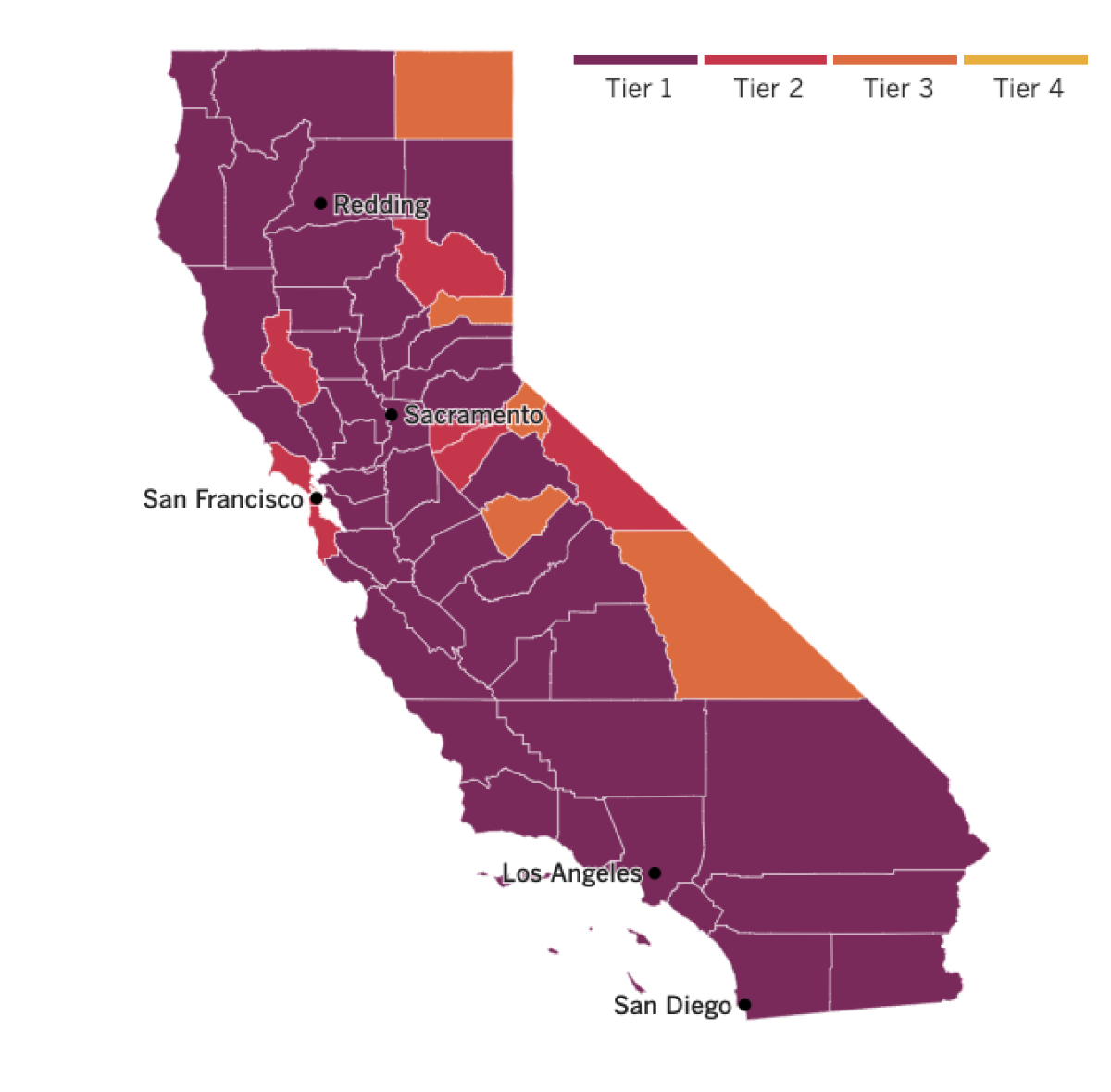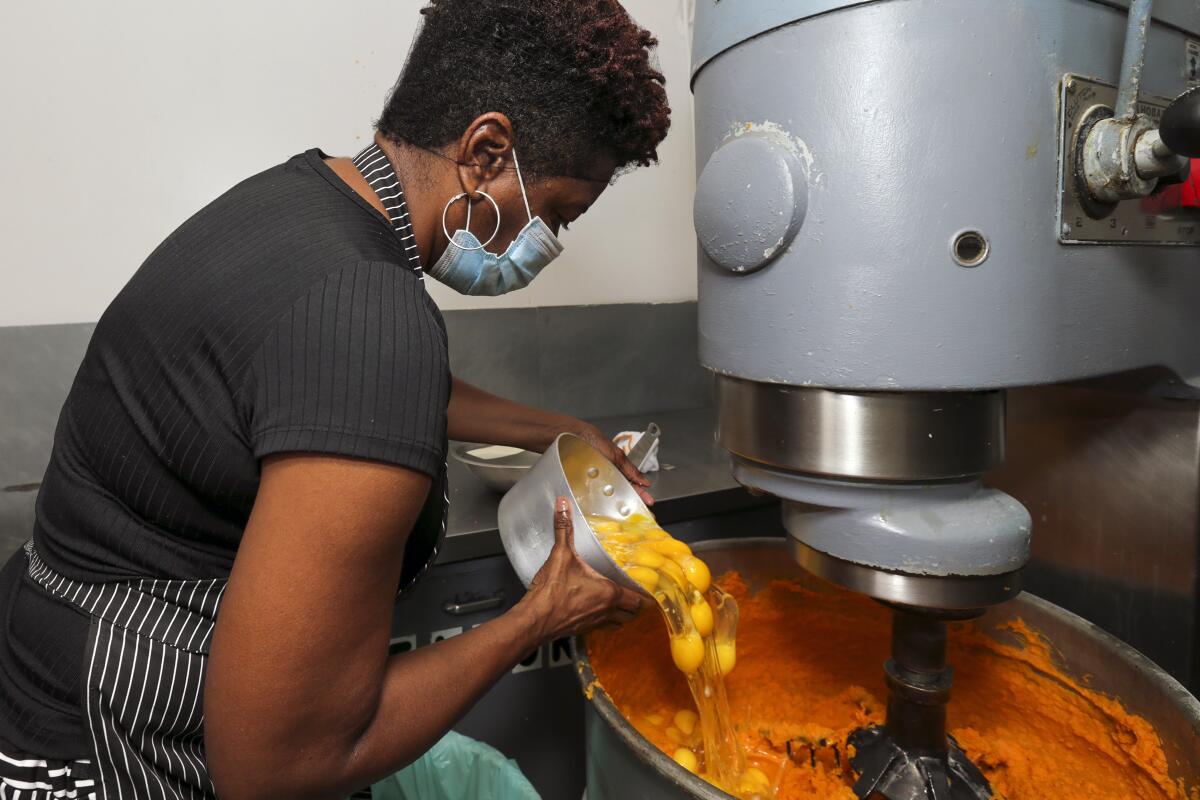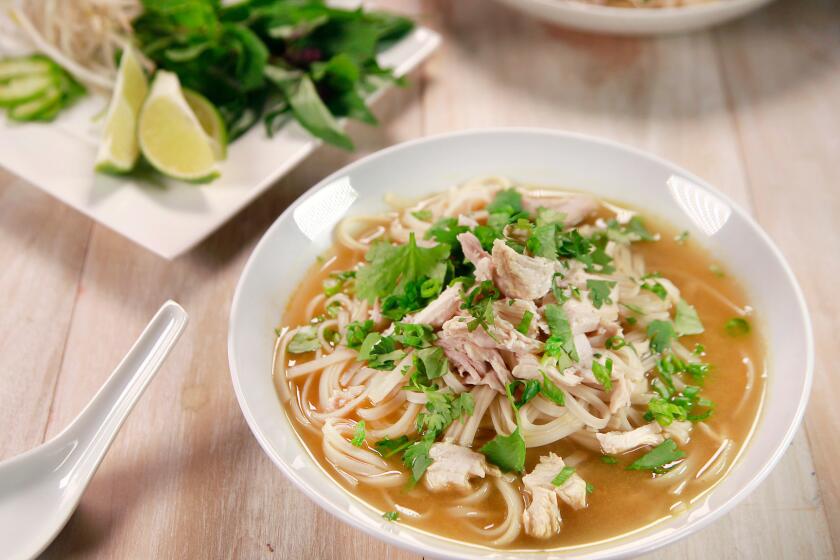Coronavirus Today: A very different Thanksgiving
Good evening. I’m Amina Khan, and it’s Wednesday, Nov. 25. Due to the Thanksgiving holiday, this is the last edition of this newsletter this week; you can expect the next one on Monday. Now, here’s what’s happening with the coronavirus in California and beyond.
It’s Thanksgiving eve, and the airports are quieter and the roads less congested than they usually would be this time of year. In normal times, many more of us would be flying cross-country or road-tripping to other states to gather with long-missed loved ones. Instead, this will be the year of turkey dinners a la Zoom and Facetimed feasts.
But my colleague Jessica Gelt offers another option for honoring the traditional day in a new way: going cold turkey on even the virtual Thanksgiving gathering.
“In this surreal pandemic year — as coronavirus infection rates and deaths soar, and local officials beg us to stay home — the holiday feels quietly somber, rather than celebratory,” she writes. “I am trying to make sense of it in my own way, trying to invent a new ritual suited to this unprecedented moment, so I have chosen to lean fully into the present without opening a digital window into another home, another town, another state.”
Gelt says she plans to devote her full attention to her husband and 4-year-old daughter.
“I am not trying to forget or neglect my faraway loved ones, or belittle the pain of those who have been alone throughout the pandemic,” Gelt writes. “I’m trying to honor them — as well as the collective suffering and sacrifice of our country — by turning this Thanksgiving into a sober day of reflection.”
While Gelt’s decision to go full analog may not be everyone’s slice of pie, she’s hardly alone in her efforts to forge something new out of a less-than-ideal holiday situation.
Noelle Carter, the former test-kitchen director for the L.A. Times, has hosted massive “Long Table” potluck-style Thanksgiving dinners for the past 17 years, with up to 85 people in attendance. This year, it will just be her and her partner Valerie at the table.
“I’d be lying if I said this didn’t hurt. But there have been over 250,000 American lives lost to COVID-19 — each one an empty seat at someone’s Thanksgiving table,” Carter writes. “Val and I feel a pause in our tradition is the only way to keep everyone safe so the Long Table can continue in the years to come.”
And they’re still going to try to make this year’s celebration special by planning a smaller, personal meal — anchored in part by signature dishes Valerie’s mother once made for the holiday.
Carter also suggests making new, meaningful traditions, such as contacting your local shelter, church or community center. Food banks are desperate for donations. You can pack up dinners for neighbors and friends who live alone or can’t gather with others because of potential health risks.
Dr. Anne K. Fishel, a psychology professor at Harvard Medical School, agrees that this is the year to embrace a new tradition. How about holding a virtual cooking class for your loved ones who may be figuring out how to prepare a turkey for the first time? Or recording family lore via Zoom? Calling the whole dinner off is totally an option, too.
“Think of it as a sabbatical year where you step away from the holiday to gain perspective,” Fishel writes in an op-ed. “Or think of the sabbatical in terms of its biblical roots, which refer to taking a year off from sowing the field. Leaving the holiday fallow may mean that next year it emerges more robustly or in a different form — the dinner could be rotated, like crops, among hosts in future years.”
And you know what? Maybe you’re just tired of all these stories about how to make Thanksgiving palatable in pandemic times. Our culture columnist and critic Mary McNamara is right there with you. Not because she can’t cook a turkey — she’ll have you know she’s an undisputed ruler of the Thanksgiving spread.
“I hate Thanksgiving dinner because I am the adult child of an alcoholic and it is the event I most associate with the emotional damage that implies,” writes McNamara. She began making her family’s entire Thanksgiving meal — turkey, stuffing, creamed onions and all — when she was just 9 or 10 years old, because “it was easier than watching my mother unravel into tears and increasingly bitter invective.”
It’s a sobering reminder that this time of year, while special for some, can also be fraught and even painful for others. Proceeding with care and caution, especially in these pandemic times, is always a good holiday-season policy.
By the numbers
California cases and deaths as of 5:20 p.m. PST Wednesday:

Track the latest numbers and how they break down in California with our graphics.
See the current status of California’s reopening, county by county, with our tracker.


Consider subscribing to the Los Angeles Times
Your support helps us deliver the news that matters most. Become a subscriber.
Across California
If you’re wondering how the pandemic has affected Thanksgiving travel, consider the “surreal” scenes at airports in Los Angeles, where you could almost — if not for the masks covering travelers’ faces — forget that a pandemic is ravaging the U.S. Monday saw passengers shuffling through check-in lines at distances far short of the minimum six feet needed for social distancing. Many clustered around luggage conveyors, waiting for their bags.
“Their presence defied both logic and health guidelines,” my colleague Hayley Smith writes. “But for some, the temptation to be with loved ones at the tail end of a trying year of fire, flood, politics and plague is too great.”
Some, like 57-year-old Kim Motz, said she had canceled plans to travel earlier in the year but did not want to miss another opportunity to be with family. “I weighed my options and felt that where I was going and who I would be with, I’d be safe,” said Motz, who arrived on a Southwest flight from San Antonio to visit her daughter and 1-year-old grandson.
“All week long, the news was saying, ‘If you travel for Thanksgiving, you’re going to die. You’ll have a funeral at Christmas,’” said Motz, who has co-workers and friends who have contracted the virus, though none have died. “I finally just had to turn it off.”
Those travelers coming into Los Angeles from out of state must now sign a form acknowledging the state’s 14-day quarantine advisory. It’s mandatory starting today — just in time to catch the last waves of Thanksgiving travelers arriving at Los Angeles International Airport, Van Nuys Airport or Union Station. Those who don’t fill out the form could face a fine of up to $500.
The form, available at travel.lacity.org, acknowledges that anyone traveling to California from other states or countries should self-quarantine for two weeks and limit interactions to their immediate household. Any travelers over age 16 must complete it. “If there’s any way you can avoid travel, cancel those plans,” Mayor Eric Garcetti said Monday. “Emergencies and essential work travel should be the only excuse that we get on a plane anywhere right now.”
It’s no secret that the pandemic has been incredibly hard on California’s small businesses, many of which are family-run and have been felled by the economic downturn. But Black-owned businesses have shouldered a disproportionate share of the burden: Forty-one percent of Black-owned businesses shut down between February and April, compared with 17% of white-owned ones, according to study published in May.
Luckily, my colleague Dorany Pineda offers a sweeter finish to the California section with her ode to a bakery weathering COVID-19 on a bustling corner in South Los Angeles.
27th Street Bakery Shop was born in 1956, the year the U.S. Supreme Court ruled that segregation on public buses was unconstitutional, and it’s still taking orders, even though the pandemic has hit sales hard.
The bakery is known for its homemade sweet potato pies, whose recipe remains a secret known to only four people. Inside, a black Blodgett oven, two radial phones and cash registers from the 1950s all share space with more modern appliances, including a credit card chip reader.
“People are really happy when they come here, and I think it’s because we help them remember when they were growing up,” said owner Jeanette Bolden-Pickens, whose grandparents founded the bakery. “So many places where you grew up aren’t there anymore. They’ve been replaced by a franchise or an apartment building. But here, you have a taste of tradition.”

Resources
— For general safety, wash your hands for at least 20 seconds (here’s a super-fun how-to video). Stop touching your face, and keep your phone clean. Practice social distancing, maintaining a six-foot radius of personal space in public. And wear a mask if you leave home. Here’s how to do it right.
— Watch for symptoms including fever, cough, shortness of breath, chills, repeated shaking with chills, muscle pain, headache, sore throat and loss of taste or smell. If you’re worried you might be infected, call your doctor or urgent care clinic before going there.
— Need a COVID-19 test? Here’s how to receive a free test if you’re in L.A. County. And here’s a map of testing sites across California.
— Here’s how to care for someone with COVID-19, from monitoring their symptoms to preventing the virus’ spread.
— If your job has been affected by the pandemic, here’s how to file for unemployment.
— Here are some free resources for restaurant workers and entertainment industry professionals having trouble making ends meet.
— Advice for helping kids navigate pandemic life includes being honest about uncertainties, acknowledging their feelings and sticking to a routine. Here’s guidance from the CDC.
— In need of mental health services? Here are resources for coping during the crisis from the CDC and the L.A. County Department of Mental Health. L.A. County residents can also call (800) 854-7771 or text “LA” to 741741.
— For domestic violence victims, the pandemic can pose a “worst-case scenario,” advocates say. If you or someone you know is experiencing such abuse, call the National Domestic Violence Hotline at 1-800-799-SAFE (7233) or L.A. County’s hotline at 1-800-978-3600. Here are more ways to get help.
Around the nation and the world
States from Nevada to New York have imposed new coronavirus rules as a wave of coronavirus cases crashes over the U.S. In Nevada, Gov. Steve Sisolak — who has avoided strengthening mandates, and who contracted the virus himself — has tightened restrictions on casinos, restaurants and private gatherings. In Nebraska, Gov. Pete Ricketts threatened tougher social-distancing rules if hospitalizations kept rising.
Colorado Gov. Jared Polis authorized the health department to order hospitals to transfer non-coronavirus patients and to stop admitting new ones in order to deal with incoming COVID-19 cases. And in Washington state, joint and heart-valve replacements and some cancer surgeries could be postponed to make room for coronavirus patients.
Christmas traditions have been cancelled in some parts of Kansas as the virus sweeps even tiny rural communities such as Norcatur, population about 150. Mayor Carl Lyon said most residents are “pretty good” about social distancing and wearing a mask, but some have caught the virus. “I know a couple of people had it, and they were still kind of running around and whatnot,” he said. “Didn’t seem to bother them that they infected everybody else.”
In Las Vegas, laid-off casino workers are turning to food banks for help, and nationwide, some 50 million people may go hungry this year due to pandemic-triggered misfortune and joblessness. The number of people going hungry in Southern Nevada climbed by 20% in the last year, and social services organizations and nonprofits are struggling to keep up with the need as they juggle their own health concerns and reduced staffing.
This coming Sunday will likely be the busiest travel day of the holiday period, and last weekend, roughly 1 million Americans boarded planes. That’s despite warnings from the Centers for Disease Control and Prevention and other officials to avoid travel, lest it fuel a worsening surge in coronavirus cases and infection rates. The U.S. has seen more than 12.7 million coronavirus cases and more than 261,000 deaths, according to Johns Hopkins University’s coronavirus tracker.
Still, the number of people flying for Thanksgiving is down by more than half from last year because of the pandemic, a sign that some are heeding health authorities’ warnings. Airline bookings this year are down roughly 60% from this time last year. And airlines have made it easier to cancel tickets and reschedule travel for safer times — which means there could be a rash of cancellations closer to the holiday, one expert said.
Regulators in Britain have yet to approve a single coronavirus vaccine, but that hasn’t stopped the country from moving to set up the distribution and delivery systems that will be needed to vaccinate millions of people.
Three vaccine candidates — by Pfizer, Moderna and AstraZeneca, respectively — have each shown very promising results in early data, with effectiveness rates at 90% and above. The recent findings have led some government leaders, including British Prime Minister Boris Johnson, to express cautious optimism that life may start returning to normal by early April.
“With a favorable wind ... we should be able to inoculate, I believe on the evidence I’m seeing, the vast majority of the people who need the most protection by Easter,” Johnson said Monday. “That will make a very substantial change to where we are at the moment.”
Britain has logged more than 55,000 deaths linked to COVID-19, in what has become Europe’s deadliest outbreak. The pandemic has put 750,000 people out of work and shuttered businesses as authorities fought to control the virus’ spread.
Now, the government has agree to buy up to 355 million doses of vaccine from seven different producers as it prepares to vaccinate as many of the country’s 67 million people as possible.
Authorities have also prioritized who will be first in line. At the head of the queue will be healthcare workers and nursing home residents, followed by people over 80. People under 65 with underlying medical conditions will come next, healthy people age 50 to 65 will follow, and finally everyone else 18 and over will get their shot.
Your questions answered
Today’s question comes from readers who want to know: How much difference do new pandemic restrictions — such as a limited nighttime curfew and suspension of outdoor restaurant dining in L.A. County — actually make in fighting the pandemic?
My colleagues Rong-Gong Lin II, Sean Greene and Luke Money are here with the answers.
On outdoor dining, restaurants have been shown to be prime spots for transmitting the coronavirus to others. For example, a CDC report found that adults with positive test results were roughly twice as likely to have reported dining at a restaurant than those who tested negative.
While the study didn’t distinguish between indoor and outdoor settings, keep in mind that you can still get infected while sitting outdoors, since diners don’t wear masks while eating and the virus can spread through talking and even just breathing.
“You’re sitting across the table from them — and you don’t have a mask on,” Dr. George Rutherford, an epidemiologist and infectious diseases expert at UC San Francisco, said of potentially coronavirus-carrying dining companions. “It’s all about mixing.”
There’s also a logic to late-night curfews, Rutherford said.
“Bad behavior goes up in the evening, at least as I recall from college,” he said. For example, when folks are out late drinking, their inhibitions tend to drop. This could mean that they may not abide by social distancing and mask-wearing as well as they would earlier in the day.
Rutherford pointed to France. After seeing a quadrupling of daily coronavirus cases over the month of October, authorities enacted stronger measures, imposing a broader curfew from 9 p.m. to 6 a.m. in the bigger cities, ordering the closure of nonessential businesses and making masks mandatory for anyone age 6 and older.
“It completely turned the corner,” Rutherford said. “The rates are dropping. ... They did this, and it seemed to work.”
Our reporters covering the coronavirus outbreak want to hear from you. Email us your questions, and we’ll do our best to answer them. You can find more answers in our Frequently Asked Questions roundup and in our reopening tracker.
For the most up-to-date coronavirus coverage from The Times over the weekend, visit our homepage and our Health section, sign up for our breaking news alerts, and follow us on Twitter and on Instagram.



